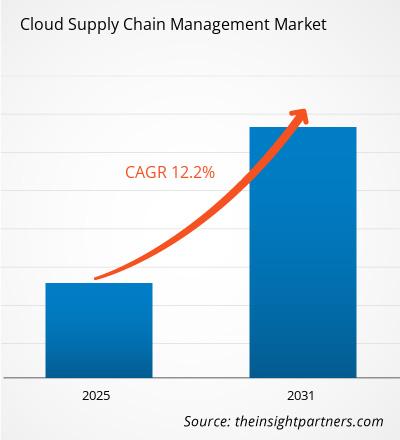预计 2023 年至 2031 年期间,云供应链管理市场的复合年增长率将达到 12.2%。更加注重新产品推出 (NPI) 的速度可能仍是市场的主要趋势。
云供应链管理市场分析
- 由于当前的市场趋势及其在预测期内可预见的影响,云供应链管理市场具有增长前景。
- 云供应链管理市场正在增长,原因包括物流行业的大幅增长、对云供应链管理解决方案优势的认识不断提高以及优化成本的需求不断增加等因素。
- 人工智能支持的无接触/低接触规划为云供应链管理市场提供了有利可图的机会。
云供应链管理市场概览
- 云供应链管理是指利用云计算服务而非现场硬件,使个人能够监督商品流动的系统、流程和工具。
- 这使得他们可以从任何位置输入和访问数据,并通过云备份提供冗余,确保供应链数据始终是最新的、可访问的,并免遭丢失、损坏或盗窃。
定制研究以满足您的需求
我们可以优化和定制标准产品无法满足的分析和范围。这种灵活性将帮助您获得业务规划和决策所需的准确信息。
云供应链管理市场:战略洞察

复合年增长率(2023 - 2031)12.2%- 2023 年市场规模
XX 百万美元 - 市场规模 2031
美元 XX 百万美元

市场动态
- 物流行业的迅猛增长、人们对云供应链管理解决方案优势的认识不断提高以及优化成本的需求日益增加
- - 支持无接触/低接触规划
- 更加关注新产品推出(NPI)的速度
关键人物
- 甲骨文
- 树液
- IBM
- 云日志
- Cloudera 公司
- JDA 软件公司
- Kinaxis(加拿大)
- Infor (美国)
- Blue Yonder 集团有限公司
- Coupa 软件公司
区域概况

- 北美
- 欧洲
- 亚太
- 南美洲和中美洲
- 中东和非洲
市场细分
 成分
成分- 解决方案
- 服务
 部署模型
部署模型- 民众
- 私人的
- 杂交种
 组织规模
组织规模- 中小企业
- 大型企业
 垂直的
垂直的- 食品和饮料
- 医疗保健与生命科学
- 制造业
- 零售和批发
- 运输与物流
- 示例 PDF 通过定性和定量分析展示了内容结构和信息的性质。
云供应链管理市场驱动因素和机遇
市场对云供应链管理解决方案优势的认识不断提高
- 云技术通过基于云的管理工具不断促进供应链管理的效率和创新。这些平台提供无与伦比的可扩展性和灵活性,使企业能够准确、快速地适应不断变化的市场需求。
- 基于云的管理工具对于供应链运营的一个主要好处是成本效益。
- 通过迁移到云解决方案,组织可以按现收现付的方式获得可扩展的资源,并最大限度地减少与传统 IT 基础设施相关的资本支出。借助这种经济模式,公司可以最大限度地降低运营成本,使支出与实际消费相匹配,并获得长期成功。
- 此外,基于云的管理平台促进了供应链生态系统内利益相关者之间的无缝协作。团队可以利用共享工作空间和集成通信技术有效地协调活动、传达重要信息并实时协作。
人工智能支持的无接触/低接触规划
- 由于持续强调弹性和 ESG,以及站点、流程和合作伙伴的增长,供应链规划面临着持续的压力。
- 事实证明,更复杂、多层次、更细微的环境需求超出了现有规划能力所能承受的范围。因此,没有多少企业能够进行有效的情景分析,以确定关键选择的财务后果。
- 支持人工智能的销售和运营计划 (S&OP) 和综合业务计划 (IBP) 应用程序将有助于消除供应链计划和执行之间的差距。
- 低接触规划将使用高级分析来回答更深层次的问题,减少人工参与,并从端到端规划过程中消除大量人工劳动。人工智能 (AI) 将能够评估大量数据、发现异常并寻找导致意外中断的趋势。
云供应链管理市场报告细分分析
有助于得出云供应链管理市场分析的关键部分是组件、部署模型、组织规模和垂直。
- 根据组成部分,市场分为解决方案和服务。
- 根据部署模式,市场分为公共、私有和混合。
- 根据组织规模,市场分为中小型企业和大型企业。
- 按垂直行业,市场分为食品和饮料、医疗保健和生命科学、制造、零售和批发、运输和物流等。
云供应链管理市场份额按地区分析
- 云供应链管理市场报告包括对五个主要地理区域的详细分析,其中包括当前和历史市场规模以及 2021 年至 2031 年的预测,涵盖北美、欧洲、亚太地区 (APAC)、中东和非洲 (MEA) 以及南美洲和中美洲。
- 每个地区进一步细分为各个国家。本报告提供 18 个国家的分析和预测,涵盖云供应链管理市场动态,例如影响区域市场的驱动因素、趋势和机会。
- 此外,该报告还涵盖了 PEST 分析,其中涉及影响这些地区云供应链管理市场的主要因素的研究。
云供应链管理市场报告范围
| 报告属性 | 细节 |
|---|---|
| 2023 年的市场规模 | XX 百万美元 |
| 2031 年市场规模 | XX 百万美元 |
| 全球复合年增长率(2023 - 2031) | 12.2% |
| 史料 | 2021-2023 |
| 预测期 | 2024-2031 |
| 涵盖的领域 | 按组件
|
| 覆盖地区和国家 | 北美
|
| 市场领导者和主要公司简介 |
|
- 示例 PDF 通过定性和定量分析展示了内容结构和信息的性质。
云供应链管理市场新闻和最新发展
通过收集一手和二手研究后的定性和定量数据来评估云供应链管理市场,其中包括重要的公司出版物、协会数据和数据库。以下列出了云供应链管理市场的一些发展情况:
- SAP SE 宣布其供应链解决方案中的 AI 进步将掀起制造业生产力、效率和精度的变革浪潮。来自实时数据的 AI 驱动洞察将帮助公司优化整个供应链的决策、简化产品开发并提高制造效率。(SAP SE,新闻稿,2024 年 4 月)
- 富士通宣布推出一项新的基于云的物流数据标准化和可视化服务,面向整个供应链中的托运人、物流公司和供应商。该服务将为客户提供新工具,以实现其运营的可持续性并应对各种挑战,包括迫在眉睫的卡车司机短缺、迫切需要减少运输的碳足迹以及遵守更严格的行业法规。(富士通,新闻稿,2023 年 12 月)
云供应链管理市场报告范围和交付成果
“云供应链管理市场规模和预测(2021-2031)”报告对以下领域进行了详细的市场分析:
- 范围内涵盖的所有关键细分市场的全球、区域和国家层面的云供应链管理市场规模和预测
- 云供应链管理市场趋势,以及驱动因素、限制因素和关键机遇等市场动态
- 详细的 PEST/波特五力分析和 SWOT 分析
- 云供应链管理市场分析涵盖主要市场趋势、全球和、主要参与者、法规和最新市场发展
- 行业格局和竞争分析,涵盖市场集中度、热图分析、知名参与者以及云供应链管理市场的最新发展
- 详细的公司简介
- 历史分析(2 年)、基准年、预测(7 年)及复合年增长率
- PEST 和 SWOT 分析
- 市场规模价值/数量 - 全球、区域、国家
- 行业和竞争格局
- Excel 数据集


- Fixed-Base Operator Market
- Pressure Vessel Composite Materials Market
- Wheat Protein Market
- Parking Management Market
- Health Economics and Outcome Research (HEOR) Services Market
- Bio-Based Ethylene Market
- Water Pipeline Leak Detection System Market
- Authentication and Brand Protection Market
- Ketogenic Diet Market
- Military Rubber Tracks Market

Report Coverage
Revenue forecast, Company Analysis, Industry landscape, Growth factors, and Trends

Segment Covered
This text is related
to segments covered.

Regional Scope
North America, Europe, Asia Pacific, Middle East & Africa, South & Central America

Country Scope
This text is related
to country scope.
常见问题
The report can be delivered in PDF/PPT format; we can also share excel dataset based on the request.
Some of the customization options available based on the request are an additional 3–5 company profiles and a country-specific analysis of 3–5 countries of your choice. Customizations are to be requested/discussed before making final order confirmation, as our team would review the same and check the feasibility.
Increased focus on the speed of new product introduction (NPI) is anticipated to play a significant role in the global cloud supply chain management market in the coming years.
The leading players operating in the cloud supply chain management market are Oracle; SAP; IBM; CloudLogix; Cloudera, Inc.; JDA Software Inc.; Kinaxis (Canada); Infor (U.S.); Blue Yonder Group, Inc.; and Coupa Software Inc.
The global cloud supply chain management market is expected to grow at a CAGR of 12.2% during the forecast period 2024 - 2031.
The huge growth of the logistics sector, growing awareness about the benefits of cloud supply chain management solutions, and the increasing need for optimizing cost are the major factors driving the cloud supply chain management market.
Trends and growth analysis reports related to Technology, Media and Telecommunications : READ MORE..
The List of Companies
1. BLUJAY SOLUTIONS
2. HIGHJUMP INC.
3. INFOR, INC
4. JDA SOFTWARE GROUP, INC.
5. KINAXIS
6. MANHATTAN ASSOCIATES
7. ORACLE CORPORATION
8. SAP SE
9. TECSYS, INC.
10. THE DESCARTES SYSTEMS GROUP INC.
The Insight Partners performs research in 4 major stages: Data Collection & Secondary Research, Primary Research, Data Analysis and Data Triangulation & Final Review.
- Data Collection and Secondary Research:
As a market research and consulting firm operating from a decade, we have published and advised several client across the globe. First step for any study will start with an assessment of currently available data and insights from existing reports. Further, historical and current market information is collected from Investor Presentations, Annual Reports, SEC Filings, etc., and other information related to company’s performance and market positioning are gathered from Paid Databases (Factiva, Hoovers, and Reuters) and various other publications available in public domain.
Several associations trade associates, technical forums, institutes, societies and organization are accessed to gain technical as well as market related insights through their publications such as research papers, blogs and press releases related to the studies are referred to get cues about the market. Further, white papers, journals, magazines, and other news articles published in last 3 years are scrutinized and analyzed to understand the current market trends.
- Primary Research:
The primarily interview analysis comprise of data obtained from industry participants interview and answers to survey questions gathered by in-house primary team.
For primary research, interviews are conducted with industry experts/CEOs/Marketing Managers/VPs/Subject Matter Experts from both demand and supply side to get a 360-degree view of the market. The primary team conducts several interviews based on the complexity of the markets to understand the various market trends and dynamics which makes research more credible and precise.
A typical research interview fulfils the following functions:
- Provides first-hand information on the market size, market trends, growth trends, competitive landscape, and outlook
- Validates and strengthens in-house secondary research findings
- Develops the analysis team’s expertise and market understanding
Primary research involves email interactions and telephone interviews for each market, category, segment, and sub-segment across geographies. The participants who typically take part in such a process include, but are not limited to:
- Industry participants: VPs, business development managers, market intelligence managers and national sales managers
- Outside experts: Valuation experts, research analysts and key opinion leaders specializing in the electronics and semiconductor industry.
Below is the breakup of our primary respondents by company, designation, and region:

Once we receive the confirmation from primary research sources or primary respondents, we finalize the base year market estimation and forecast the data as per the macroeconomic and microeconomic factors assessed during data collection.
- Data Analysis:
Once data is validated through both secondary as well as primary respondents, we finalize the market estimations by hypothesis formulation and factor analysis at regional and country level.
- Macro-Economic Factor Analysis:
We analyse macroeconomic indicators such the gross domestic product (GDP), increase in the demand for goods and services across industries, technological advancement, regional economic growth, governmental policies, the influence of COVID-19, PEST analysis, and other aspects. This analysis aids in setting benchmarks for various nations/regions and approximating market splits. Additionally, the general trend of the aforementioned components aid in determining the market's development possibilities.
- Country Level Data:
Various factors that are especially aligned to the country are taken into account to determine the market size for a certain area and country, including the presence of vendors, such as headquarters and offices, the country's GDP, demand patterns, and industry growth. To comprehend the market dynamics for the nation, a number of growth variables, inhibitors, application areas, and current market trends are researched. The aforementioned elements aid in determining the country's overall market's growth potential.
- Company Profile:
The “Table of Contents” is formulated by listing and analyzing more than 25 - 30 companies operating in the market ecosystem across geographies. However, we profile only 10 companies as a standard practice in our syndicate reports. These 10 companies comprise leading, emerging, and regional players. Nonetheless, our analysis is not restricted to the 10 listed companies, we also analyze other companies present in the market to develop a holistic view and understand the prevailing trends. The “Company Profiles” section in the report covers key facts, business description, products & services, financial information, SWOT analysis, and key developments. The financial information presented is extracted from the annual reports and official documents of the publicly listed companies. Upon collecting the information for the sections of respective companies, we verify them via various primary sources and then compile the data in respective company profiles. The company level information helps us in deriving the base number as well as in forecasting the market size.
- Developing Base Number:
Aggregation of sales statistics (2020-2022) and macro-economic factor, and other secondary and primary research insights are utilized to arrive at base number and related market shares for 2022. The data gaps are identified in this step and relevant market data is analyzed, collected from paid primary interviews or databases. On finalizing the base year market size, forecasts are developed on the basis of macro-economic, industry and market growth factors and company level analysis.
- Data Triangulation and Final Review:
The market findings and base year market size calculations are validated from supply as well as demand side. Demand side validations are based on macro-economic factor analysis and benchmarks for respective regions and countries. In case of supply side validations, revenues of major companies are estimated (in case not available) based on industry benchmark, approximate number of employees, product portfolio, and primary interviews revenues are gathered. Further revenue from target product/service segment is assessed to avoid overshooting of market statistics. In case of heavy deviations between supply and demand side values, all thes steps are repeated to achieve synchronization.
We follow an iterative model, wherein we share our research findings with Subject Matter Experts (SME’s) and Key Opinion Leaders (KOLs) until consensus view of the market is not formulated – this model negates any drastic deviation in the opinions of experts. Only validated and universally acceptable research findings are quoted in our reports.
We have important check points that we use to validate our research findings – which we call – data triangulation, where we validate the information, we generate from secondary sources with primary interviews and then we re-validate with our internal data bases and Subject matter experts. This comprehensive model enables us to deliver high quality, reliable data in shortest possible time.

 获取此报告的免费样本
获取此报告的免费样本